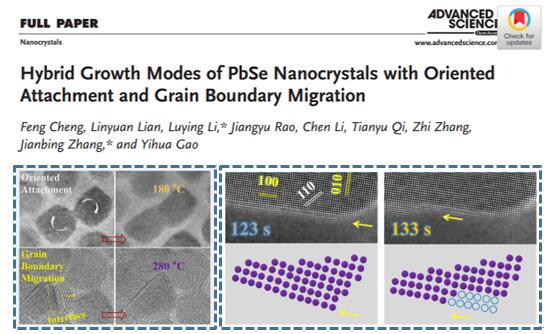
The comprehensive science journal《Advanced science》recently reported the current research results “Hybrid Growth Modes of PbSe Nanocrystals with Oriented Attachment and Grain Boundary Migration”, which were completed by Associate Prof. Luying Li (Group member of Prof. Yihua Gao in Wuhan National Laboratory for Optoelectronics) and Associate Prof. Jianbin Zhang (School of Optical and Electronic Information, Huazhong University of Science and Technology).
The material growth is a prerequisite for its study and application. In recent research on nanomaterials, the related growth modes of nanomaterials have received more and more attention. Oriented attachment is widely reported as the main growth mode of many nanomaterials, the corresponding growth process is mainly achieved by the spontaneous spatial rotation of nanomaterials at high temperatures, which normally requires high degree of freedom. However, in many cases, nanomaterials will aggregate and contact with each other during the growth process, and the contact of multiple interfaces will directly lead to the decrease of the degree of freedom. In most studies, the effect of changing spatial freedom on the growth mode of nanomaterials are often neglected without any systematic studies.
In the current study, the relatively stable PbSe nanocrystals are systematically studied using in-situ thermal technique of transmission electron microscopy. The growth mode transitions under different degrees of freedom and corresponding atomic motions within the nanocrystalline materials are directly observed at atomic resolution. The results show that: PbSe nanocrystals mainly follow the oriented attachment growth mode with high degree of freedom, and the surface/interfacial atoms diffuse to lower the system energy; PbSe nanocrystals mainly follow the grain boundary migration growth mode with low degree of freedom, the process of grain boundary migration is mainly realized through the interfacial atomic reconstruction and the entire processes are regulated by the interface stress. The contact of neighboring nanocrystals would introduce a large number of dislocations at the interface, which facilitate the release of interfacial stress, thereby inhibiting the transformation of the interfacial structure. This work directly demonstrates two different growth modes of nanocrystals during growth by in-situ thermal studies, and the related atomic motions under different growth modes, which would help researchers to better understand the growth process of similar nanocrystals, and facilitate tailoring the growth process of related nanomaterials.
This work was supported by the National Natural Science Foundation (51871104,11674113,11874025), Hubei Provincial Natural Science Foundation (2017CFB417) and Special Funds for Fundamental Scientific Research Business Expenses of Central Universities (No.2017KFYXJJ039). Associate Prof. Luying Li and Associate Prof. Jianbin Zhang are corresponding authors of this work, and Ph.D. students Feng Cheng and Linyuan Lian are equally contributing as first co-authors, Jiangyu Rao, Chen Li, Tianyu Qi, Associate Professor Zhi Zhang and Professor Yihua Gao are also involved in final completion of this work.
Paper links: https://onlinelibrary.wiley.com/doi/full/10.1002/advs.201802202